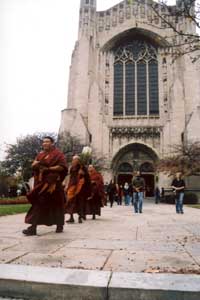Rockefeller Memorial Chapel will be home to new Inter-religious center
By Peter SchulerNews Office
 Last month, Buddhist monks processed from Rockefeller Memorial Chapel after they dismantled their Sand Mandala. The ceremony was one of many events at the chapel that reflect the religious diversity of the campus community. The new Inter-religious Center will expand the chapel’s efforts that celebrate many faith traditions. |
Rockefeller Memorial Chapel, celebrating its 75th year serving the University community, will be the site of a new Inter-religious Center that will consolidate many student religious activities on campus.
“This is a marvelous way for the chapel to continue to be relevant for a community whose religious complexion has totally changed since Rockefeller Chapel was built in 1928,” said Alison Boden, Dean of Rockefeller Memorial Chapel and Senior Lecturer in the Divinity School and the College.
In 1928, said Boden, there was mandatory weekly attendance at a Christian service. “We are now a community of Christians, Muslims, Jews, Hindus, Buddhists, Bahai’s, Sikh’s, Jain’s and more, and that’s all to the good.”
Unused space in the chapel basement will be converted into five large rooms-two dedicated for Muslim and Hindu use and three more of varying sizes for other religious faiths to share. Completion of the new Inter-religious Center is expected in the summer or fall of 2004. Boden asked various groups to share their ideas and needs with the architect, Nevin Hedlund, a noted designer of religious facilities.
“One of the foremost teachings of Baha’u’llah, the founder of the Baha’i Faith, is that there is an inherent unity in all religions,” said Erica Delgado, a student at the Pritzker School of Medicine and a member of the University Baha’i Association. “It will be wonderful to come together in a new center where the sacred writings from all faiths can be shared.”
Until it was razed in the 1970s, there had been a building at the corner of 58th Street and Woodlawn Avenue that was used as prayer space for different religious groups on campus. Since then, religious groups have found spaces for their services in a variety of available rooms in University buildings, including the Joseph Regenstein Library. “Many of our peer institutions, such as MIT, Johns Hopkins and Columbia, have a center of this type or are building one,” Boden said.
Rabbi David Rosenberg, Executive Director of the Johanna and Herman H. Newberger Hillel Center on Woodlawn Avenue and Chairman of the Campus Ministers Association, noted that the center would “not only serve the needs of students who wish to celebrate their faith, but it also will benefit the broader community of students, faculty and staff. The center will be a wonderful resource for the chapel as well as for the social, spiritual and intellectual life of the University as a whole.”
Boden and her staff have been very active in fostering understanding among the various religious groups on campus. “It is impossible to overstate the importance of the work that Dean Boden has sponsored at the chapel to promote inter-religious dialogue,” said Richard Rosengarten, Dean of the Divinity School and Associate Professor in the Divinity School and the College.
“The center will be a wonderful institutional marker and a boon to that effort, and it surely will be a centerpiece of the chapel’s work on campus in the years ahead.”
Talha Noor Muhammad, a fourth-year in the College and a leader of the Muslim Students Association on campus, echoed Rosengarten’s sentiments. “This is a great opportunity for students of different religions to interact with each other, not just in an academic setting but in a religious and sacred one, to learn the rich cultures of many faiths.”
![[Chronicle]](/images/sidebar_header_oct06.gif)